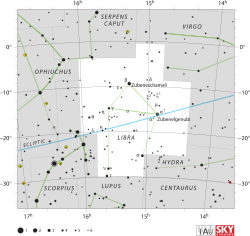Beta Librae

The position of β Librae (circled) | |
| Observation data Epoch J2000 Equinox J2000 | |
|---|---|
| Constellation | Libra |
| Right ascension | 15h 17m 00.41382s[1] |
| Declination | −09° 22′ 58.4919″[1] |
| Apparent magnitude (V) | 2.61[2] |
| Characteristics | |
| Spectral type | B8 V[3] |
| U−B color index | −0.359[4] |
| B−V color index | −0.106[4] |
| Variable type | Suspected |
| Astrometry | |
| Radial velocity (Rv) | −35.2[2] km/s |
| Proper motion (μ) | RA: −98.10[1] mas/yr Dec.: −19.65[1] mas/yr |
| Parallax (π) | 17.62 ± 0.16[1] mas |
| Distance | 185 ± 2 ly (56.8 ± 0.5 pc) |
| Details | |
| Mass | 3.5+0.3 −0.2[3] M☉ |
| Radius | 4.9[5] R☉ |
| Luminosity | 130 L☉ |
| Temperature | 12,300[6] K |
| Metallicity [Fe/H] | 0.33[3] dex |
| Rotational velocity (v sin i) | 250[7] km/s |
| Age | 80+50 −40[3] Myr |
| Other designations | |
Beta Librae (β Lib, β Librae) is the Bayer designation for a star in the zodiac constellation of Libra. It has the traditional name Zubeneschamali /ˌzuːbənˌɛʃəˈmeɪli/ and the Latin name Lanx Borealis,[9] meaning "the northern scale [of the Balance]". The name Zubeneschamali is derived from the Arabic الزبن الشمالية (al-zuban al-šamāliyya) meaning "The Northern Claw".[10] The apparent visual magnitude of this star is 2.6,[2] making it the brightest member of Libra. From parallax measurements, its distance can be estimated as 185 light-years (57 parsecs) from Earth.[1]
Description
Based upon the features of its spectrum, Beta Librae has a stellar classification of B8 V,[3] making it a B-type main sequence star. It is about 130 times more luminous than the Sun and has a surface temperature of 12,300 K,[6] double that of the Sun. This high temperature produces light with a simple spectrum, making it ideal for examining the interstellar gas and dust between us and the star. Like many stars of its kind, it is spinning rapidly, over 100 times faster than the Sun with a projected rotational velocity of 250 km s–1.[7] The measured angular diameter of the primary star is 0.801 mas.[6] At the estimated distance of this system, this yields a physical size of about 4.9 times the radius of the Sun.[5] This type of massive, hydrogen-fusing star often appears blue-white, but Beta Librae is often described as greenish, the only greenish star visible to the naked eye.[11]
The small periodic variations in the magnitude of the Beta Librae suggests the presence of a companion star which is not directly observable from earth.[12] However, it is presently categorized as a single star.[13]
History
According to Eratosthenes Beta Librae was observed to be brighter than Antares. Ptolemy, three hundred and fifty years later, said it was as bright as Antares. The discrepancy may be due to Antares becoming brighter, but this is not known for certain. It could simply be caused by Beta Librae being a variable star, showing a present day variability of 0.03 of a magnitude.[10]
See also
- List of stars in Libra
- Beta Librae in fiction
- Zubenelgenubi
References
- ↑ 1.0 1.1 1.2 1.3 1.4 1.5 van Leeuwen, F. (November 2007). "Validation of the new Hipparcos reduction". Astronomy and Astrophysics 474 (2): 653–664. arXiv:0708.1752. Bibcode:2007A&A...474..653V. doi:10.1051/0004-6361:20078357.
- ↑ 2.0 2.1 2.2 Wielen, R. et al. (1999), Sixth Catalogue of Fundamental Stars (FK6). Part I. Basic fundamental stars with direct solutions (35), Astronomisches Rechen-Institut Heidelberg, Bibcode:1999VeARI..35....1W.
- ↑ 3.0 3.1 3.2 3.3 3.4
- ↑ 4.0 4.1 Gutierrez-Moreno, Adelina; Moreno, Hugo (June 1968), "A photometric investigation of the Scorpio-Centaurus association", Astrophysical Journal Supplement 15: 459, Bibcode:1968ApJS...15..459G, doi:10.1086/190168
- ↑ 5.0 5.1 Lang, Kenneth R. (2006), Astrophysical formulae, Astronomy and astrophysics library 1 (3 ed.), Birkhäuser, ISBN 3540296921. The radius (R*) is given by:
- ↑ 6.0 6.1 6.2 Zorec, J. et al. (July 2009), "Fundamental parameters of B supergiants from the BCD system. I. Calibration of the (λ_1, D) parameters into Teff", Astronomy and Astrophysics 501 (1): 297–320, Bibcode:2009A&A...501..297Z, doi:10.1051/0004-6361/200811147
- ↑ 7.0 7.1 Abt, Helmut A.; Levato, Hugo; Grosso, Monica (July 2002), "Rotational Velocities of B Stars", The Astrophysical Journal 573 (1): 359–365, Bibcode:2002ApJ...573..359A, doi:10.1086/340590
- ↑ "HD 135742 -- Variable Star", SIMBAD Astronomical Object Database, retrieved 2007-01-22
- ↑ La Hire, Philippe (1727), Tabulae Astronomicae, see star table, page 13.
- ↑ 10.0 10.1 AAS (2006), "LIBRA – A Balanced View (page 7 of PDF)", Auckland Astronomical Society, retrieved 2009-01-25
- ↑ Kaler, James B. (2006), "Zubeneschamali", Stars (University of Illinois), retrieved 2006-07-03
- ↑ Mark Fisher (1999-2006), "Zuben Elschemali", The Electronic Sky, retrieved 2009-01-25
- ↑ Eggleton, P. P.; Tokovinin, A. A. (September 2008). "A catalogue of multiplicity among bright stellar systems". Monthly Notices of the Royal Astronomical Society 389 (2): 869–879. arXiv:0806.2878. Bibcode:2008MNRAS.389..869E. doi:10.1111/j.1365-2966.2008.13596.x.
External links
- Odeh, Moh'd (1998-2006), "Arabic Star Names", Islamic Crescents' Observation Project, retrieved 2006-07-03 – Find more Arabic Star Names and their meanings.
| ||||||||||||||||||||||||||
